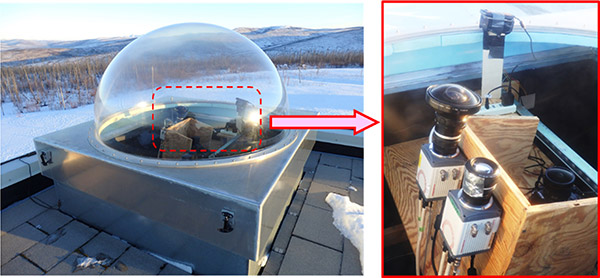National Institute of Polar Research
Successful filming of fastest aurora flickering
Released on May 19, 2017 (in Japanese)
Posted on August 10, 2017
National Institute of Polar Research
The University of Tokyo
Nagoya University
Kyoto University
University of Alaska, Fairbanks
University of Southampton
The word "aurora" invokes an image of a slowly shimmering curtain of light illuminating the sky. However, when an explosive aurora occurs, known as a breakup, it sometimes leads to another phenomenon called "flickering". When an aurora "flickers" its brightness and motion in some areas begin to change rapidly. This flickering typically oscillates at a 1/10 second period, which is equivalent to the ion cyclotron frequency (*1) of oxygen ions.
Dr. Yoko Fukuda (formally of the Graduate School of Science at The University of Tokyo), Dr. Ryuho Kataoka of the National Institute of Polar Research, and other collaborators conducted a 3 year continuous high-speed imaging observation at Poker Flat Research Range, Alaska, USA, and identified the physics behind the flickering. At the same time, they discovered faster flickerings at speeds of 1/60~1/50 and 1/80 of a second.
On March 19, 2016, the researchers observed an aurora with the brightness that ranked within the top 5 of all observations since 2014, and was filmed with a 1/160 second shutter speed camera. Detailed analysis of the footage showed a high-speed flickering aurora vibrating with a 1/80 second period taking place during the brightest moment of the breakup.
"High-speed flickering at 1/80 seconds could not be explained by oxygen ions alone. Lighter ions, such as those from hydrogen, are thought to be contributing to the flickering," explains Dr. Fukuda. "The fact that this high-speed flickering was observed at the same time as flickering with a typical 1/10 second period may mean that the flickering aurora was caused by 'electromagnetic ion cyclotron waves' (*2), which are affected by both oxygen and hydrogen ions."
At altitudes of several thousand kilometers, various plasma waves are excited by accelerating electrons and ions. These electrons are what eventually generate auroras. It is assumed that a complex exchange of energy, in which plasma waves are affected by electrons and ions and vice versa, takes place here.
"Astronomical objects with magnetic fields are found throughout the cosmos, with Earth being one of them. On such objects, we observe excitation of plasma waves by accelerating particles, and the interactions between plasma waves and particles, are occurring all over the place," concludes Dr. Kataoka. "However, Earth is the only place we can observe these phenomena in detail. Understanding the behavior of plasma in outer space, and the interactions between plasma waves and particles is a fundamental question in geophysics. We will continue to investigate them in the future."
*1: Ion cyclotron frequency
The circular motion of electrons and ions around a magnetic field line is called cyclotron motion. Ion cyclotron frequency is the number of times per second that the electrons and ions circle around the field line. It is inversely proportional to the mass of the electrons and ions—the frequency is greater if the mass is lighter. The frequency also correlates with the strength of the magnetic field; it is greater at lower altitudes where the magnetic field is stronger.
*2: Electromagnetic ion cyclotron waves
A type of wave that can exist in a plasma (such as the region of space above Earth's aurora), which vibrates at an ion cyclotron frequency that corresponds to the ion type present (oxygen, helium, hydrogen, etc.).
Video 1: Flickering aurora. The pale pink area at the center is flickering.
Filmed by: Ayumi Y. Bakken, filmed at: Fairbanks, AK, USA; filming date: March 18, 2015; playback speed: 1x

Fig. 1: High-speed cameras installed at the Neal Davis Science Operations Center at the Poker Flat Research Range of the University of Alaska.
Video 2: Flickering aurora that appeared on a part of the turbulence structure.
This 1-second segment is replayed at 1/4 speed. The fastest flickering was observed in the areas marked ×.
Published Paper
Journal: Geophysical Research Letters
Title: First evidence of patchy flickering aurora modulated by multi-ion electromagnetic ion cyclotron waves
Authors:
Yoko Fukuda1,2 , Ryuho Kataoka2,3 , Herbert Akihito Uchida3 , Yoshizumi Miyoshi4 , Donald Hampton5 , Kazuo Shiokawa4 , Yusuke Ebihara6 , Daniel Whiter7 , Naomoto Iwagami1, and Kanako Seki1
1 Department of Earth and Planetary Science, The University of Tokyo, Tokyo, Japan
2 National Institute of Polar Research, Tokyo, Japan
3 Department of Polar Science, The Graduate University for Advanced Studies (SOKENDAI), Tokyo, Japan
4 Institute for Space-Earth Environmental Research, Nagoya University, Nagoya, Japan
5 Geophysical Institute, University of Alaska Fairbanks, Fairbanks, Alaska, USA
6 Research Institute for Sustainable Humanosphere, Kyoto University, Kyoto, Japan
7 School of Physics and Astronomy, University of Southampton, Southampton, UK
URL:http://onlinelibrary.wiley.com/doi/10.1002/2017GL072956/abstract
DOI:10.1002/2017GL072956
Published date: 13 May, 2017
Funder
This work was supported by Grants-in-Aid for Scientific Research (19403010; 25302006; 15H05747; 15H05815; 16H06286) from the Ministry of Education, Culture, Sports, Science and Technology of Japan. This work was carried out by the joint research program of the Institute for Space-Earth Environmental Research (ISEE), Nagoya University. Yoko Fukuda was supported by Grant-in-Aid for JSPS Fellows 15J07466. Ryuho Kataoka was supported by the Yamada Science Foundation.
Contact
Public Relations Section, National Institute of Polar Research
E-mail: kofositu@nipr.ac.jp








